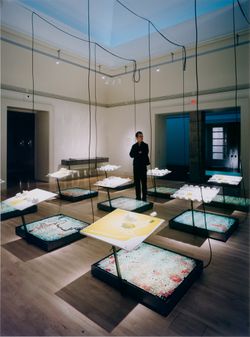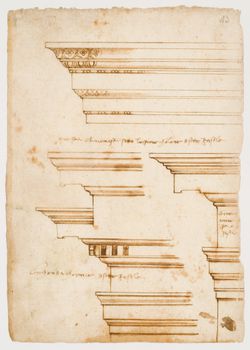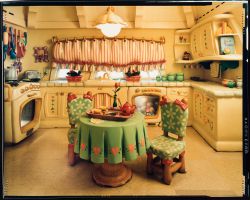Series
James Stirling papers
AP140.S1
Description:
Series documents James Stirling student years and military service throughout his student projects, some personal documents and collected artworks and photographic materials. The bulk of the material in this series relates to James Stirling's student work at the Liverpool School of Architecture in Liverpool, England, and at the Association for Planning and Regional Reconstruction in London, England, between 1948 and 1952. Also included in this series are a few personal documents relating to his military service in the Second World War and its relation to his university education. Series also consists of drawings executed by Stirling as a student, other drawings collected by Stirling as gifts from friends and colleagues, and photographs and negatives taken by Stirling of architectural subject matters. Material in this series was produced between probably 1939 and 1990. Series contains architectural drawings, textual records, photographic materials and a presentation model, as well as other drawings, including several portraits and caricatures of James Stirling.
circa 1939-1990
James Stirling papers
Actions:
AP140.S1
Description:
Series documents James Stirling student years and military service throughout his student projects, some personal documents and collected artworks and photographic materials. The bulk of the material in this series relates to James Stirling's student work at the Liverpool School of Architecture in Liverpool, England, and at the Association for Planning and Regional Reconstruction in London, England, between 1948 and 1952. Also included in this series are a few personal documents relating to his military service in the Second World War and its relation to his university education. Series also consists of drawings executed by Stirling as a student, other drawings collected by Stirling as gifts from friends and colleagues, and photographs and negatives taken by Stirling of architectural subject matters. Material in this series was produced between probably 1939 and 1990. Series contains architectural drawings, textual records, photographic materials and a presentation model, as well as other drawings, including several portraits and caricatures of James Stirling.
Series 1
circa 1939-1990
Sub-series
Architectural projects
AP140.S2.SS1
Description:
Sub-series documents competition entries and projects by James Stirling, and by the successive firms of James Stirling; Stirling and Gowan; James Stirling and Partner; James Stirling, Michael Wilford, and Associates; Michael Wilford and Partners; and Michael Wilford GmbH. Several projects were carried out in association with other architects, including Léon Krier, Walter Nägeli, and the firms of Giancarlo de Carlo and of Marlies Hentrup Norbert Heyer. A majority of projects were designed for London, England and other locations in England and Scotland, Germany and the United States. Other projects were designed for Italy, Iran, Japan, France, Algeria, Spain, Netherlands, Kenya, Qatar, Canada, Singapore and Switzerland. Material in this sub-series was produced between 1951 and probably 2004. The publication drawings for Stirling's projects were often drawn by Leon Krier, Russell Bevington, or Ulrich Schaad ('British Architecture Today', 1991). Sub-series contains reference drawings, conceptual and design development drawings, publication and presentation drawings and panels, and working drawings. It also contains photographic materials, textual records, models and artefacts.
1951-2004
Architectural projects
Actions:
AP140.S2.SS1
Description:
Sub-series documents competition entries and projects by James Stirling, and by the successive firms of James Stirling; Stirling and Gowan; James Stirling and Partner; James Stirling, Michael Wilford, and Associates; Michael Wilford and Partners; and Michael Wilford GmbH. Several projects were carried out in association with other architects, including Léon Krier, Walter Nägeli, and the firms of Giancarlo de Carlo and of Marlies Hentrup Norbert Heyer. A majority of projects were designed for London, England and other locations in England and Scotland, Germany and the United States. Other projects were designed for Italy, Iran, Japan, France, Algeria, Spain, Netherlands, Kenya, Qatar, Canada, Singapore and Switzerland. Material in this sub-series was produced between 1951 and probably 2004. The publication drawings for Stirling's projects were often drawn by Leon Krier, Russell Bevington, or Ulrich Schaad ('British Architecture Today', 1991). Sub-series contains reference drawings, conceptual and design development drawings, publication and presentation drawings and panels, and working drawings. It also contains photographic materials, textual records, models and artefacts.
Sub-Series 1
1951-2004
archives
Level of archival description:
Fonds
Peter Caspari fonds
AP123
Synopsis:
The Peter Caspari fonds documents the education, personal and military activities of architect Peter Caspari from student work in Berlin to his immigration to England, and participation in WWII. The majority of the documents in the fonds consist of drawings relating to student building design projects, and textual records relating to architecture course notes, training for the Pioneer Corps, and professional registration as an architect.
1928-1941
Peter Caspari fonds
Actions:
AP123
Synopsis:
The Peter Caspari fonds documents the education, personal and military activities of architect Peter Caspari from student work in Berlin to his immigration to England, and participation in WWII. The majority of the documents in the fonds consist of drawings relating to student building design projects, and textual records relating to architecture course notes, training for the Pioneer Corps, and professional registration as an architect.
archives
Level of archival description:
Fonds
1928-1941
The American Lawn: Surface of Everyday Life reveals the lawn as a domestic symbol, civic showplace, economic force, and national icon. Bungalows in tract developments, suburban corporate headquarters, and the White House are all alike in that they sit behind a lawn: a carefully contrived patch of “nature” that lies open to the sky and to a multitude of uses and(...)
Main galleries, octagonal gallery, and hall cases
16 June 1998 to 8 November 1998
The American Lawn: Surface of Everyday Life
Actions:
Description:
The American Lawn: Surface of Everyday Life reveals the lawn as a domestic symbol, civic showplace, economic force, and national icon. Bungalows in tract developments, suburban corporate headquarters, and the White House are all alike in that they sit behind a lawn: a carefully contrived patch of “nature” that lies open to the sky and to a multitude of uses and(...)
Main galleries, octagonal gallery, and hall cases
2016 Visiting Scholar Cara Rachele presents her research: This lecture investigates the explosion of detail drawings in the Renaissance. It connects the emergence of the detail in the sixteenth century as a canonical drawing type with the evocation of the material antique. The organic evolution of the detail drawing method can be seen in the sketchbooks of everyday(...)
11 August 2016, 6pm
Visiting Scholar Seminar: Cara Rachele
Actions:
Description:
2016 Visiting Scholar Cara Rachele presents her research: This lecture investigates the explosion of detail drawings in the Renaissance. It connects the emergence of the detail in the sixteenth century as a canonical drawing type with the evocation of the material antique. The organic evolution of the detail drawing method can be seen in the sketchbooks of everyday(...)
A revolutionary approach to the relationship between building and landscape, which shaped them together according to peculiarly American ideals, is the subject of Frank Lloyd Wright: Designs for an American Landscape, 1922–1932. In this exhibition, the CCA reconstructs five unbuilt, visionary projects that imagined nothing less than a new American landscape, integrating(...)
Main galleries
18 June 1996 to 29 September 1996
Frank Lloyd Wright: Designs for an American Landscape, 1922-1932
Actions:
Description:
A revolutionary approach to the relationship between building and landscape, which shaped them together according to peculiarly American ideals, is the subject of Frank Lloyd Wright: Designs for an American Landscape, 1922–1932. In this exhibition, the CCA reconstructs five unbuilt, visionary projects that imagined nothing less than a new American landscape, integrating(...)
Main galleries
Realism and Illusion: Catherine Wagner Photographs the Disney Theme Parks presents a visual essay of the Disney theme parks in Anaheim, Orlando, Tokyo, and Paris. Fascinated by the importance of illusion in the design and layout of the parks, Wagner aspired “to add yet another layer of deception to this already simulated world, our world, where illusion is now more real(...)
Octagonal gallery
17 June 1997 to 28 September 1997
Realism and Illusion: Catherine Wagner Photographs the Disney Theme Parks
Actions:
Description:
Realism and Illusion: Catherine Wagner Photographs the Disney Theme Parks presents a visual essay of the Disney theme parks in Anaheim, Orlando, Tokyo, and Paris. Fascinated by the importance of illusion in the design and layout of the parks, Wagner aspired “to add yet another layer of deception to this already simulated world, our world, where illusion is now more real(...)
Octagonal gallery
archives
Level of archival description:
Fonds
AP075
Synopsis:
The Cornelia Hahn Oberlander fonds documents Oberlander's professional activities as a landscape architect. It contains over 203 projects that span from 1950 to 2018 predominantly in Canada and in the United States, but also in Germany. The fonds is a complete record of Oberlander's work, and comprises her playground projects, roof gardens, and public space landscapes, as well as landscape designs for private residences, as well as administrative records from her practice, her professional engagements, and her research materials. The material in this fonds is dated from 1936 to 2021.
1936-2021
Cornelia Hahn Oberlander fonds
Actions:
AP075
Synopsis:
The Cornelia Hahn Oberlander fonds documents Oberlander's professional activities as a landscape architect. It contains over 203 projects that span from 1950 to 2018 predominantly in Canada and in the United States, but also in Germany. The fonds is a complete record of Oberlander's work, and comprises her playground projects, roof gardens, and public space landscapes, as well as landscape designs for private residences, as well as administrative records from her practice, her professional engagements, and her research materials. The material in this fonds is dated from 1936 to 2021.
archives
Level of archival description:
Fonds
1936-2021
drawings, textual records
AP154.S2.001
Description:
Wooden box with tongue-in-groove sliding cover and label of Giovanni Pasanella Architect on top. Contains photographs and other presentation materials mounted on board. Projects represented: Twin Parks, Bronx, New York, N.Y.; House for Mr. & Mrs. R.C. Lemon, Bedford, New York; Firehouse for Engine Company 283, Ladder Company Squad 4, Brooklyn, New York; vacation house on Cape Cod House for Dr. and Mrs. Alan Grey; House in Winhall, Vermont; Intensive Therapy Center for Infants, Willowbrook State School, Staten Island, New York ; Science Building II, College at Potsdam, State University of New York; Administration Building, College at Potsdam, State University of New York; "The new city: architecture and urban renewal: The Museum of Modern Art, New York" by Jacquelin T. Robertson, Richard Weinstein, Giovanni Pasanella and others; City Hall, Emergency Operating Center Study, University of Kentucky. Also contains 2 Prospectus for Giovanni Pasanella Architect A.I.A. (portfolios)
1968 or 1969
Wooden box containing presentation material
Actions:
AP154.S2.001
Description:
Wooden box with tongue-in-groove sliding cover and label of Giovanni Pasanella Architect on top. Contains photographs and other presentation materials mounted on board. Projects represented: Twin Parks, Bronx, New York, N.Y.; House for Mr. & Mrs. R.C. Lemon, Bedford, New York; Firehouse for Engine Company 283, Ladder Company Squad 4, Brooklyn, New York; vacation house on Cape Cod House for Dr. and Mrs. Alan Grey; House in Winhall, Vermont; Intensive Therapy Center for Infants, Willowbrook State School, Staten Island, New York ; Science Building II, College at Potsdam, State University of New York; Administration Building, College at Potsdam, State University of New York; "The new city: architecture and urban renewal: The Museum of Modern Art, New York" by Jacquelin T. Robertson, Richard Weinstein, Giovanni Pasanella and others; City Hall, Emergency Operating Center Study, University of Kentucky. Also contains 2 Prospectus for Giovanni Pasanella Architect A.I.A. (portfolios)
drawings, textual records
1968 or 1969
Project
AP154.S1.1979.PR01
Description:
Project series AP154.S1.1979.PR01, George & Annette Murphy Center at Asphalt Green, New York, N.Y. (1979), documents an executed project to recycle a municipal asphalt plant into a youth sports and arts center. Clients for the project were the New York City Department of General Services and the Neighborhood Committee for the Asphalt Green, chaired by Dr. George Murphy. The asphalt plant was a parabolic structure built in the 1940s by the firm Kahn and Jacobs. Pasanella + Klein worked on the adaptive reuse project with HOK, successors to Kahn and Jacobs. The transformed interior includes two gymnasia of different sizes, a running track, art and photography studios, offices, lockers, showers and a theatre. The design includes an on-site total energy plant. The project series consists of presentation drawings. References: Kerr, Laurie. "Back to the future", Oculus, v. 64, no. 7/8 (March/April 2002), p. 7-8. Dixon, John Morris. "25-year watch", Oculus, v. 71, issue 1 (spring 2009) Doubilet, Susan. "Arch support", Progressive architecture, v. 66, no. 11 (Nov. 1985), p. 101 Architektur + Wettbewerbe, 127 (Sept. 1986), p. 16-17
between 1979 and 1984?
George & Annette Murphy Center at Asphalt Green, New York, N.Y. (1979)
Actions:
AP154.S1.1979.PR01
Description:
Project series AP154.S1.1979.PR01, George & Annette Murphy Center at Asphalt Green, New York, N.Y. (1979), documents an executed project to recycle a municipal asphalt plant into a youth sports and arts center. Clients for the project were the New York City Department of General Services and the Neighborhood Committee for the Asphalt Green, chaired by Dr. George Murphy. The asphalt plant was a parabolic structure built in the 1940s by the firm Kahn and Jacobs. Pasanella + Klein worked on the adaptive reuse project with HOK, successors to Kahn and Jacobs. The transformed interior includes two gymnasia of different sizes, a running track, art and photography studios, offices, lockers, showers and a theatre. The design includes an on-site total energy plant. The project series consists of presentation drawings. References: Kerr, Laurie. "Back to the future", Oculus, v. 64, no. 7/8 (March/April 2002), p. 7-8. Dixon, John Morris. "25-year watch", Oculus, v. 71, issue 1 (spring 2009) Doubilet, Susan. "Arch support", Progressive architecture, v. 66, no. 11 (Nov. 1985), p. 101 Architektur + Wettbewerbe, 127 (Sept. 1986), p. 16-17
Project
between 1979 and 1984?



